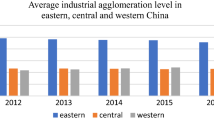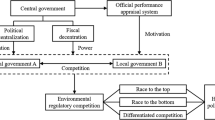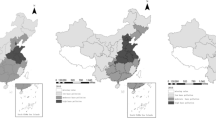Abstract
Haze pollution has drawn lots of public concern due to its potential damages to human health. Strategic interaction of environmental regulation among local governments may lead to a race to the bottom and hinder air quality improvement. Still, current empirical evidence is scarce, especially from developing countries. Based on province-level panel data from 2004 to 2015, the paper employs a dynamic fixed effect spatial Durbin model to identify interactive patterns of environmental regulation and then investigate its environmental impact. Empirical results indicate that regional differences are observed in environmental regulation and haze pollution, and high-high and low-low clusters dominate the spatial pattern. Interactive patterns of economically similar provinces are dominated by strategic substitution, whereas provinces sharing common borders or belonging to the same region are dominated by strategic complementation. Further, both race to the bottom and race to the top effect are discovered in the asymmetric test. The reaction coefficient values are much more extensive when competitors implement laxer policies, indicating a more significant racing trend to the bottom. Overall, after controlling for the spillover effect and hysteresis effect of haze pollution, the strategic interaction of environmental regulation among provinces is not conducive to improve air quality. The consequence might be correlated with low environmental standards, weak regulation enforcement, and the “free-ride” motive in China. These findings will be of great significance for optimizing local government behavior and improving air quality.





Similar content being viewed by others
Data availability
Data are available.
References
Anselin, L., Sridharan, S., & Gholston, S. (2007). Using exploratory spatial data analysis to leverage social indicator databases: The discovery of interesting patterns. Social Indicators Research, 82(2), 287–309.
Anselin, L. (1988). Spatial econometrics: Methods and models. Dordrecht: Springer. https://doi.org/10.1007/978-94-015-7799-1.
Bai, J. H., Lu, J. Y., & Li, S. J. (2019). Fiscal pressure, tax competition and environmental pollution. Environmental & Resource Economics, 73(2), 431–447.
Becker, R., & Henderson, V. (2000). Effects of air quality regulations on polluting industries. Journal of Political Economy, 108(2), 379–421.
Besley, T., & Case, A. (1995). Incumbent behavior: Vote-seeking, tax-setting, and yardstick competition. American Economic Review, 85(1), 25–45.
Brauer, M., Freedman, G., Frostad, J., van Donkelaar, A., Martin, R. V., & Dentener, F. (2016). Ambient air pollution exposure estimation for the global burden of disease 2013. Environmental Science & Technology, 50(1), 79–88.
Brueckner, J. K. (2003). Strategic interaction among governments: An overview of empirical studies. International Regional Science Review, 26(2), 175–188.
Brueckner, J. K., & Saavedra, L. A. (2001). Do local governments engage in strategic property-tax competition? National Tax Journal, 54(2), 203–229.
Bu, M. L., & Wagner, M. (2016). Racing to the bottom and racing to the top: The crucial role of firm characteristics in foreign direct investment choices. Journal of International Business Studies, 47(9), 1032–1057.
Chen, Y. J., Li, P., & Lu, Y. (2018). Career concerns and multitasking local bureaucrats: Evidence of a target-based performance evaluation system in China. Journal of Development Economics, 133, 84–101.
Chirinko, R. S., & Wilson, D. J. (2017). Tax competition among U.S. States: racing to the bottom or riding on a seesaw? Journal of Public Economics, 155, 147–163.
Chung, S. H. (2014). Environmental regulation and foreign direct investment: Evidence from South Korea. Journal of Development Economics, 108, 222–236.
Costa-Font, J., De-Albuquerque, F., & Doucouliagos, H. (2015). Does inter-jurisdictional competition engender a “race to the bottom”? A meta-regression analysis. Economics & Politics, 27(3), 488–508.
Deng, H. H., Zheng, X. Y., Huang, N., & Li, F. H. (2012). Strategic interaction in spending on environmental protection: Spatial evidence from Chinese cities. China & World Economy, 20(5), 103–120.
Deng, J. Q., Zhang, N., Ahmad, F., & Draz, M. U. (2019). Local government competition, environmental regulation intensity and regional innovation performance: An empirical investigation of Chinese provinces. International Journal of Environmental Research and Public Health, 16(12), 2130.
Dietz, T., & Rosa, E. A. (1994). Rethinking the environmental impacts of population, affluence, and technology. Human Ecology Review, 1(2), 277–300.
Dong, F., Zhang, S. N., Long, R. Y., Zhang, X. Y., & Sun, Z. Y. (2019). Determinants of haze pollution: An analysis from the perspective of spatiotemporal heterogeneity. Journal of Cleaner Production, 222, 768–783.
Ehrlich, P. R., & Holdren, J. P. (1971). Impacts of population growth. Science, 171(3977), 1212–1217.
Elhorst, J. P., & Freret, S. (2009). Evidence of political yardstick competition in France using a two-regime spatial Durbin model with fixed effects. Journal of Regional Science, 49(5), 931–951.
Feng, T., Du, H. B., Lin, Z. G., & Zuo, J. (2020). Spatial spillover effects of environmental regulations on air pollution: Evidence from urban agglomerations in China. Journal of Environmental Management, 272, 110998.
Fredriksson, P. G., & Millimet, D. L. (2002). Strategic interaction and the determination of environmental policy across U.S. States. Journal of Urban Economics, 51(1), 101–122.
Galinato, G. I., & Chouinard, H. H. (2018). Strategic interaction and institutional quality determinants of environmental regulations. Resource and Energy Economics, 53, 114–132.
Ge, T., Qiu, W., Li, J. Y., & Hao, X. L. (2020). The impact of environmental regulation efficiency loss on inclusive growth: Evidence from China. Journal of Environmental Management, 268, 110700.
Greenstone, M. (2002). The impacts of environmental regulations on industrial activity: Evidence from the 1970 and 1977 Clean Air Act Amendments and the Census of Manufactures. Journal of Political Economy, 110(6), 1175–1219.
Grossman, G. M., & Krueger, A. B. (1991). Environmental impacts of a North American Free Trade Agreement. NBER Working Paper. https://doi.org/10.3386/w3914.
Hao, Y., Peng, H., Temulun, T., Liu, L. Q., Mao, J., Lu, Z. N., et al. (2018a). How harmful is air pollution to economic development? New evidence from PM2.5 concentrations of Chinese cities. Journal of Cleaner Production, 172, 743–757.
Hao, Y., Deng, Y. X., Lu, Z. N., & Chen, H. (2018b). Is environmental regulation effective in China? Evidence from city-level panel data. Journal of Cleaner Production, 188, 966–976.
Hayashi, M., & Yamamoto, W. (2016). Information sharing, neighborhood demarcation, and yardstick competition: An empirical analysis of intergovernmental expenditure interaction in Japan. International Tax and Public Finance, 24(1), 134–163.
Henderson, J. V. (1996). Effects of air quality regulation. American Economic Review, 86(4), 789–813.
Hong, T., Yu, N. N., & Mao, Z. G. (2019). Does environment centralization prevent local governments from racing to the bottom? Evidence from China. Journal of Cleaner Production, 231, 649–659.
Jaffe, A. B., Peterson, S. R., Portney, P. R., & Stavins, R. N. (1995). Environmental regulation and the competitiveness of US. Manufacturing. Journal of Economic Literature, 33(1), 132–163.
Jiang, J. J., Ye, B., Zhou, N., & Zhang, X. L. (2019). Decoupling analysis and environmental Kuznets curve modelling of provincial-level CO2 emissions and economic growth in China: A case study. Journal of Cleaner Production, 212, 1242–1255.
Kelejian, H. H., & Prucha, I. R. (1998). Generalized spatial two-stage least squares procedure for estimating a spatial autoregressive model with autoregressive disturbances. Journal of Real Estate Finance and Economics, 17(1), 99–121.
Konisky, D. M. (2007). Regulatory competition and environmental enforcement: Is there a race to the bottom. American Journal of Political Science, 51(4), 853–872.
Konisky, D. M., & Woods, N. D. (2012). Measuring state environmental policy. Review of Policy Research, 29(4), 544–569.
Kostka, G. (2014). Barriers to the implementation of environmental policies at the local level in China. Policy Research Working Paper, (pp. 1–51). https://EconPapers.repec.org/RePEc:wbk:wbrwps:7016.
Kostka, G., & Nahm, J. (2017). Central–local relations: Recentralization and environmental governance in China. China Quarterly, 231, 567–582.
Lai, Y. B. (2019). Environmental policy competition and heterogeneous capital endowments. Regional Science and Urban Economics, 75, 107–119.
Lelieveld, J., Evans, J. S., Fnais, M., Giannadaki, D., & Pozzer, A. (2015). The contribution of outdoor air pollution sources to premature mortality on a global scale. Nature, 525(7569), 367–371.
Levinson, A. (2003). Environmental regulatory competition: A status report and some new evidence. National Tax Journal, 56(1), 91–106.
Li, H., & Zhou, L. A. (2005). Political turnover and economic performance: The incentive role of personnel control in China. Journal of Public Economics, 89(9–10), 1743–1762.
Li, H., Zhang, M., Li, C., & Li, M. (2019a). Study on the spatial correlation structure and synergistic governance development of the haze emission in China. Environmental Science and Pollution Research, 26(12), 12136–12149.
Li, L., Liu, X. M., Ge, J. J., Chu, X. H., & Wang, J. (2019b). Regional differences in spatial spillover and hysteresis effects: A theoretical and empirical study of environmental regulations on haze pollution in China. Journal of Cleaner Production, 230, 1096–1110.
List, J. A., & Gering, S. (2000). Regulatory Federalism and Environmental Protection in the United States. Journal of Regional Science, 40(3), 453–471.
Liu, H. M., Fang, C. L., Zhang, X. L., Wang, Z. Y., Bao, C., & Li, F. Z. (2017). The effect of natural and anthropogenic factors on haze pollution in Chinese cities: A spatial econometrics approach. Journal of Cleaner Production, 165, 323–333.
Liu, J., Zhao, Y. H., Cheng, Z. H., & Zhang, H. M. (2018). The effect of manufacturing agglomeration on haze pollution in China. International Journal of Environmental Research and Public Health, 15(11), 2490.
Liu, Y. J., & Dong, F. (2019). How industrial transfer processes impact on haze pollution in China: An analysis from the perspective of spatial effects. International Journal of Environmental Research and Public Health, 16(3), 423.
Liu, Z. D., Cai, Y., & Hao, X. J. (2020). The agglomeration of manufacturing industry, innovation and haze pollution in China: Theory and evidence. International Journal of Environmental Research and Public Health, 17(5), 1670.
Millimet D. (2013). Environmental federalism: A survey of the empirical literature. IZA Discussion Paper No.7831, 783, 2–46. https://ssrn.com/abstract=2372540.
Millimet, D. L. (2003). Assessing the empirical impact of environmental federalism. Journal of Regional Science, 43(4), 711–733.
Millimet, D. L., & List, J. A. (2003). A natural experiment on the ‘race to the bottom’ hypothesis: Testing for stochastic dominance in temporal pollution trends. Oxford Bulletin of Economics and Statistics, 65(4), 395–420.
Ministry of Ecology and Environment of the People’s Republic of China (MEEPRC). (2019). Bulletin on the State of the Ecological Environment in China. http://www.mee.gov.cn/hjzl/sthjzk/zghjzkgb/. Accessed 25 August 2020.
Monogan, J. E., Konisky, D. M., & Woods, N. D. (2017). Gone with the wind: Federalism and the strategic location of air polluters. American Journal of Political Science, 61(2), 257–270.
Oates, W., & Schwab, R. (1988). Economic competition among jurisdictions: Efficiency enhancing or distortion inducing? Journal of Public Economics, 35(3), 333–354.
Pan, X. F., Li, M. N., Guo, S. C., & Pu, C. X. (2020). Research on the competitive effect of local government’s environmental expenditure in China. Science of the Total Environment, 718, 137238.
Parchet, R. (2019). Are local tax rates strategic complements or strategic substitutes? American Economic Journal: Economic Policy, 11(2), 189–224.
Peng, X. (2020). Strategic interaction of environmental regulation and green productivity growth in China: Green innovation or pollution refuge? Science of the Total Environment, 732, 139200.
Porter, M. E., & van der Linde, C. (1995). Toward a new conception of the environment-competitiveness relationship. Journal of Economic Perspectives, 9(4), 97–118.
Revelli, F. (2006). Performance rating and yardstick competition in social service provision. Journal of Public Economics, 90(3), 459–475.
Rivera, J., & Oh, C. H. (2013). Environmental regulations and multinational corporations’ foreign market entry investments. Policy Studies Journal, 41(2), 243–272.
Shi, H. X., Wang, S. Y., Li, J., & Zhang, L. (2020). Modeling the impacts of policy measures on resident’s PM2.5 reduction behavior: An agent-based simulation analysis. Environmental Geochemistry and Health, 42(3), 895–913.
Shi, X. Z., & Xu, Z. F. (2018). Environmental regulation and firm exports: Evidence from the eleventh Five-Year Plan in China. Journal of Environmental Economics and Management, 89, 187–200.
Sui, X. M., Zhang, J. Q., Zhang, Q., Sun, S., Lei, R. Q., Zhang, C., et al. (2020). The short-term effect of PM2.5/O(3) on daily mortality from 2013 to 2018 in Hefei China. Environmental Geochemistry and Health. https://doi.org/10.1007/s10653-020-00689-x.
Sun, C. W., Luo, Y., & Li, J. L. (2018). Urban traffic infrastructure investment and air pollution: Evidence from the 83 cities in China. Journal of Cleaner Production, 172, 488–496.
Tang, J. T. (2015). Testing the pollution haven effect: Does the type of FDI matter? Environmental & Resource Economics, 60(4), 549–578.
Tian, Z. H., Tian, Y. F., Chen, Y., & Shao, S. (2020). The economic consequences of environmental regulation in China: From a perspective of the environmental protection admonishing talk policy. Business Strategy and the Environment, 29(4), 1723–1733.
Tiebout, C. M. (1956). A pure theory of local expenditures. Journal of Political Economy., 64(5), 416–424.
van der Kamp, D., Lorentzen, P., & Mattingly, D. (2017). Racing to the bottom or to the top? Decentralization, revenue pressures, and governance reform in China. World Development, 95, 164–176.
van Rooij, B., Zhu, Q. Q., Na, L., & Wang, Q. L. (2017). Centralizing trends and pollution law enforcement in China. China Quarterly, 231, 583–606.
Vrijburg, H., & de Mooij, R. A. (2016). Tax rates as strategic substitutes. International Tax and Public Finance, 23(1), 2–24.
Wang, H., Mamingi, N., Laplante, B., & Dasgupta, S. (2003). Incomplete enforcement of pollution regulation: Bargaining power of Chinese factories. Environmental & Resource Economics, 24(3), 245–262.
Wang, H., & Wheeler, D. (2005). Financial incentives and endogenous enforcement in China’s pollution levy system. Journal of Environmental Economics and Management, 49(1), 174–196.
Woods, N. D. (2006). Interstate competition and environmental regulation: A test of the race-to-the-bottom thesis. Social Science Quarterly, 87(1), 174–189. https://doi.org/10.1111/j.0038-4941.2006.00375.x.
Wu, J., Deng, Y. H., Huang, J., Morck, R., & Yeung, B. (2013). Incentives and Outcomes: China’s Environmental Policy. NBER Working Paper. https://doi.org/10.3386/w18754.
Wu, X., Gao, M., Guo, S., & Li, W. (2019). Effects of environmental regulation on air pollution control in China: A spatial Durbin econometric analysis. Journal of Regulatory Economics, 55(3), 307–333.
Wu, J. N., Xu, M. M., & Zhang, P. (2018). The impact of governmental performance assessment policy and citizen participation on improving environmental performance across Chinese provinces. Journal of Cleaner Production, 184, 227–238.
Xie, R. H., Yuan, Y. J., & Huang, J. J. (2017). Different types of environmental regulations and heterogeneous influence on “green” productivity: Evidence from China. Ecological Economics, 132, 104–112.
Yang, J., Guo, H. X., Liu, B. B., Shi, R., Zhang, B., & Ye, W. L. (2018). Environmental regulation and the pollution haven hypothesis: Do environmental regulation measures matter? Journal of Cleaner Production, 202, 993–1000.
Yu, Y. H., Zhang, L., Li, F. H., & Zheng, X. Y. (2013). Strategic interaction and the determinants of public health expenditures in China: A spatial panel perspective. Annals of Regional Science, 50(1), 203–221.
Yu, J. H., Zhou, L. A., & Zhu, G. Z. (2016). Strategic interaction in political competition: Evidence from spatial effects across Chinese cities. Regional Science and Urban Economics, 57, 23–37.
Zhang, G. X., Liu, W., & Duan, H. B. (2020a). Environmental regulation policies, local government enforcement and pollution-intensive industry transfer in China. Computers & Industrial Engineering, 148, 106748.
Zhang, K. K., Xu, D. Y., Li, S. R., Wu, T., & Cheng, J. H. (2021). Strategic interactions in environmental regulation enforcement: Evidence from Chinese cities. Environmental Science and Pollution Research, 28(2), 1992–2006. https://doi.org/10.1007/s11356-020-10443-6.
Zhang, Z. B., Jin, T. J., & Meng, X. H. (2020b). From race-to-the-bottom to strategic imitation: How does political competition impact the environmental enforcement of local governments in China? Environmental Science and Pollution Research, 27(20), 25675–25688.
Zhang, P., & Wu, J. N. (2018). Impact of mandatory targets on PM2.5 concentration control in Chinese cities. Journal of Cleaner Production, 197, 323–331.
Zhang, P., & Wu, J. N. (2019). Performance targets, path dependence, and policy adoption: Evidence from the adoption of pollutant emission control policies in Chinese provinces. International Public Management Journal, 23(3), 405–420.
Zhang, Q., Zheng, Y. X., Tong, D., Shao, M., Wang, S. X., Zhang, Y. H., et al. (2019). Drivers of improved PM2.5 air quality in China from 2013 to 2017. Proceedings of the National Academy of Sciences of the United States of America, 116(49), 24463–24469.
Zheng, S. Q., Kahn, M. E., Sun, W. Z., & Luo, D. L. (2014). Incentives for China’s urban mayors to mitigate pollution externalities: The role of the central government and public environmentalism. Regional Science and Urban Economics, 47, 61–71.
Zhu, W. W., Yao, N. Z., Guo, Q. Z., & Wang, F. B. (2020). Risk perception and willingness to mitigate climate change: City smog as an example. Environmental Geochemistry and Health, 42(3), 881–893.
Acknowledgments
This study is supported by the National Social Science Fund of China (Grant Nos.17BJL041, 16BJL036).
Funding
This work was supported by the National Social Science Fund of China (Grant numbers 17BJL041 and 16BJL036).
Author information
Authors and Affiliations
Contributions
Conceptualization, L.L. and J.S.; Methodology, J.S. and J.J.; Project administration, L.L.; Software, J.S.; Supervision, J.J.and J.W.; Writing – original draft, J.S.; Writing – review & editing, J.J. and J.W.
Corresponding author
Ethics declarations
Conflict of interests
The authors declare they have no conflicts of interests.
Animal research
Not applicable.
Consent to participate and Consent to publish
Not applicable.
Additional information
Publisher's Note
Springer Nature remains neutral with regard to jurisdictional claims in published maps and institutional affiliations.
Rights and permissions
About this article
Cite this article
Li, L., Sun, J., Jiang, J. et al. The effect of environmental regulation competition on haze pollution: evidence from China’s province-level data. Environ Geochem Health 44, 3057–3080 (2022). https://doi.org/10.1007/s10653-021-00854-w
Received:
Accepted:
Published:
Issue Date:
DOI: https://doi.org/10.1007/s10653-021-00854-w




